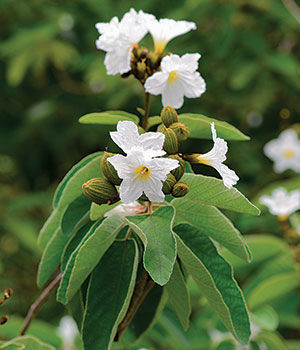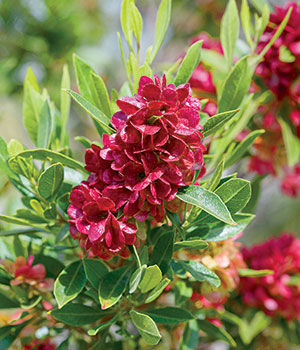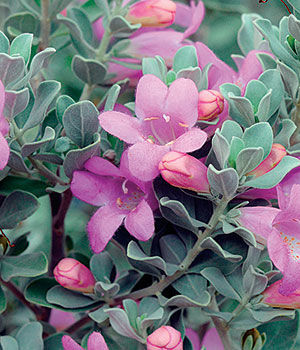
Everyone enjoys spring gardens, with the fresh foliage and colorful flowers that lift our spirits after a long, dull winter. And summer gardens are glorious, of course, with an abundance of bold blooms and rich colors that perfectly suit outdoor summer activities. By August, though, heat and dry spells take their toll on spring and summer perennials; gardens can look tired and tattered.
Time to retreat indoors? No way. Below are four plants that keep the interest going in August and into autumn.
1. Texas Olive

Name: Cordia boissieri
Zones: 9–11
Size: 10 to 15 feet tall and wide
Conditions: Full sun to partial shade; well-drained soil
Native range: Texas and Mexico
Texas olive can be kept as a shrub or be pruned into a small tree for a courtyard or by a patio. It is an excellent choice for along walls and can be used as a screen if left unpruned. It also makes a great background plant for other smaller succulents, shrubs, or herbaceous perennials. Texas olive is considered a slow grower, so it may take a few seasons to establish the height and width you desire. Its white flowers bloom year-round except during cold winters, and it does produce olivelike fruits, but they aren’t edible. Its dark green leaves are oval-shaped and feel fuzzy or velvetlike to the touch. Best of all, it’s an evergreen, so you get that continuous cover and color throughout fall and winter.
2. Hopbush

Name: Dodonaea viscosa
Zones: 9–11
Size: 6 to 12 feet tall and 4 to 10 feet wide
Conditions: Full sun to partial shade; well-drained soil
Native range: Mexico and Southwestern United States
If you are looking for a shrub that is lush, you have found it. Hopbush is excellent for screening, does well around pools (it tolerates high heat), and lends a subtropical feel to the landscape. It is also a nice choice for a hedge. The white flowers are inconspicuous and bloom during the spring months with papery-winged seedpods similar to what you would find on the hops used for beer making—thus the name. The pods can be red (pictured), pink, green, yellow, or tan. Hopbush is a moderate to fast grower and stays evergreen through the fall and winter as long as temperatures don’t go too low.
3. Texas Sage

Name: Leucophyllum frutescens
Zones: 8–11
Size: 6 feet tall and 8 feet wide
Conditions: Full sun; well-drained soil
Native range: Texas and Mexico
Another great evergreen for fall is Texas sage. Although its silver-gray, velvetlike foliage is stunning, it’s the spectacular purple, bell-shape flowers that make this plant a great addition to your garden palette. The blossom show is strongest in fall too, when other shrubs are winding down for winter. Texas sage actually blooms in response to the returning autumn rains. During the rest of the year, you can count on this tough shrub to tolerate extreme heat and long periods of drought.
4. Slipper Plant

Name: Pedilanthus macrocarpus
Zones: 9–11
Size: 3 to 5 feet tall and 3 to 4 feet wide
Conditions: Full sun to partial shade; well-drained soil
Native range: Sonoran Desert of northwestern Mexico and Baja California
This is a beautiful succulent that produces orange-red, slipperlike flowers at the tips of its stems from spring to early fall. If you want to invite hummingbirds into your garden, this is a must-have perennial. Slipper plant does well in containers but is also an excellent choice for hot, refl ected areas of the garden, or planted en masse along walls or fences for a striking effect. The plant forms multistemmed green or gray clumps over time. These stems can be smooth or slightly rough and exude a white milky sap if pruned or broken. Be sure to keep the irritating sap away from eyes and skin.
Tina Wilson is the director of horticulture at the Desert Botanical Garden in Phoenix.
Photos: millettephotomedia (1, 3); Joshua McCullough (2); Bill Johnson (4)
Fine Gardening Recommended Products

Gardener's Supply Company Summerweight Fabric Plant Cover
Fine Gardening receives a commission for items purchased through links on this site, including Amazon Associates and other affiliate advertising programs.

VegTrug Classic Cold Frame
Fine Gardening receives a commission for items purchased through links on this site, including Amazon Associates and other affiliate advertising programs.

Nesco Snackmaster Express Food Dehydrator
Fine Gardening receives a commission for items purchased through links on this site, including Amazon Associates and other affiliate advertising programs.


















Comments
Log in or create an account to post a comment.
Sign up Log in